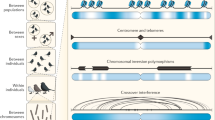Abstract
Meiotic recombination occurs preferentially at certain regions in the genome referred to as hot spots which are important for generating genetic diversity and proper segregation of chromosomes during meiosis. Although observations concerning individual hotspots have given clues as to the mechanism of recombination initiation, the nature and causes of recombination rate variation in the genome are still little known. A rational solution is to estimate and rank recombination rates along the genome. Therefore, it is a high demand for a database that deposits and integrates those data to provide a systematical repository of genome-wide recombination rates. Homologous recombination hotspots database is a web-based database of meiotic recombination rates, which comprises enormous data and information of human, mouse, rat, D. melanogaster, C. elegans and yeast. Users can query the database in several alternative ways. The database stores various details for every sequence, such as chromosome number, hyperlinks to the respective reference, and the sequence in FASTA format.
Similar content being viewed by others
References
Sun H, Treco D, Schultes N P, et al. Double-strand breaks at an initiation site for meiotic gene conversion. Nature, 1989, 338:87–90
Jeffreys A J, Holloway J K, Kauppi L, et al. Meiotic recombinationhot spot and human DNA diversity. Philos Trans R Soc Lond B Biol Sci, 2004, 359:141–152
Kauppi L, Jeffreys A J, Keeney S. Where the crossovers are: Recombination distributions in mammals. Nat Rev Genet, 2004, 5:413–424
Lichten M, Goldman A S. Meiotic recombination hotspots. Annu Rev Genet, 1995, 29:423–444
Petes T D. Meiotic recombination hot spots and cold spots. Nat Rev Genet, 2001, 2:360–369
Van Endert P M, Lopez M T, Patel S D, et al. Genomic polymorphism, recombination, and linkage disequilibrium in human major histocompatibility complex-encoded antigen-processing genes. Proc Natl Acad Sci USA, 1992, 89:11594–11597
Begovich A B, McClure G R, Suraj V C, et al. Polymorphism, recombination, and linkage disequilibrium within the HLA class II region. J Immunol, 1992, 148:249–258
Kauppi L, Sajantila A, Jeffreys A J. Recombination hotspots rather than population history dominate linkage disequilibrium in the MHC class II region. Hum Mol Genet, 2003, 12:33–40
Andolfatto P, Wall J D. Linkage disequilibrium patters across a recombination gradient in African Drosophila melanogaster. Genetics, 2003, 165:1289–1305
Li N, Stephens M. Modeling linkage disequilibrium and identifying recombination hotspots using single-nucleotide polymorphism data. Genetics, 2003, 165:2213–2233
Clark A G, Nielsen R, Signorovitch J, et al. Linkage disequilibrium and inference of ancestral recombination in 538 single-nucleotide polymorphism clusters across the human genome. Am J Hum Genet, 2003, 73:285–300
Nishant K T, Kumar C, Rao M R. HUMHOT: A database of human meiotic recombination hot spots. Nucleic Acid Res, 2006, 34(Database issue):35–38
McVean G A, Myers S R, Hunt S, et al. The fine-scale structure of recombination rate variation in the human genome. Science, 2004, 304:581–584
Jensen-Seaman M I, Furey T S, Payseur B A, et al. Comparative recombination rates in the rat, mouse, and human genomes. Genome Res, 2004. 14:528–538
Steen R G, Kwitek-Black A E, Glenn C, et al. A high-density integrated genetic linkage and radiation hybrid map of the laboratory rat. Genome Res, 1999, 9:AP1–8
Dietrich W F, Miller J, Steen R, et al. A comprehensive genetic map of the mouse genome. Nature, 1996, 380:149–152
Kong A, Gudbjartsson D F, Sainz J, et al. A high-resolution recombination map of the human genome. Nat Genet, 2002, 31:241–247
Broman K W, Murray J C, Sheffield V C, et al. Comprehensive human genetic maps: Individual and sex-specific variation in recombination. Am J Hum Genet, 1998, 63:861–869
Myers S, Bottolo L, Freeman C, et al. A fine-scale map of recombination rates and hotspots across the human genome. Science, 2005, 310:321–324
Marais G, Mouchiroud D, Duret L. Does recombination improve selection on codon usage? Lessons from nematode and fly complete genomes. Proc Natl Acad Sci USA, 2001, 98:5688–5692
Gerton J L, DeRisi J, Shroff R, et al. Inaugural article: Global mapping of meiotic recombination hotspots and coldspots in the yeast Saccharomyces cerevisiae. Proc Natl Acad Sci USA, 2000, 97:11383–11390
Arnheim N, Calabrese P, Nordborg M. Hot and cold spots of recombination in the human genome: The reason we should find them and how this can be achieved. Am J Hum Gent, 2003, 73:5–16
Saccharomyces Genome Database [http://www.yeastgenome.org/]
Reich D E, Schaffner S F, Daly M J, et al. Human genome sequence variation and the influence of gene history, mutation and recombination. Nat Genet, 2002, 32:135–142
Aquadro C F. Insights into the evolutionary process from patterns of DNA sequence variability. Curr Opin Genet Dev, 1997, 7:835–840
Fullerton S M, Bernardo C A, Clark A G. Local rates of recombination are positively correlated with GC content in the human genome. Mol Biol Evol, 2001, 18:1139–1142
Jiang P, Wu H, Wei J, et al. RF-DYMHC: Detecting the yeast meiotic recombination hotspots and coldspots by random forest model using gapped dinucleotide composition features. Nucleic Acids Res, 2007, 35:47–51
Zhou T, Weng J, Sun X, et al. Support vector machine for classification of meiotic recombination hotspots and coldspots in Saccharomyces cerevisiae based on codon composition. BMC Bioinformatics, 2006, 7:223
Chen L, Zhao H. Negative correlation between compositional symmetries and local recombination rates. Bioinformatics, 2005, 21:3951–3958
Author information
Authors and Affiliations
Corresponding author
About this article
Cite this article
Sang, F., Jiang, P., Wang, W. et al. ReDB: A meiotic homologous recombination rate database. Chin. Sci. Bull. 55, 3169–3173 (2010). https://doi.org/10.1007/s11434-010-3029-3
Received:
Accepted:
Published:
Issue Date:
DOI: https://doi.org/10.1007/s11434-010-3029-3




